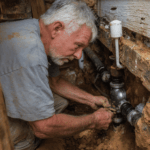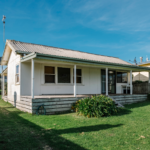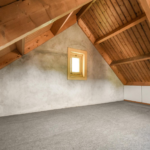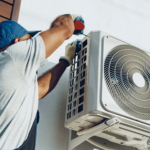
Even small tweaks to your daily routine and HVAC setup can make a noticeable impact on your home’s comfort and energy bills. These quick, practical fixes don’t require major renovations, just smarter habits and small upgrades that work together for lasting efficiency.
Quick Home Energy Efficiency Tips That Really Work
Think of home energy efficiency tips as a series of small systems working together, not one big fix. The goal is to reduce what your home wastes as much as what it uses.
Start by focusing on what’s often invisible: seal gaps around windows, doors, outlets, and attic access points, it’s like patching a leaky tire. Anything that hums, glows, or stays warm when “off” is still using standby power, so use smart plugs or a surge strip to eliminate that ghost load. Run dishwashers and laundry during off-peak hours if your utility offers time-of-use rates.
Stop thinking of “saving energy” as sacrifice, think of it as optimizing comfort with less waste. Most homes don’t have an energy use problem, they have an energy awareness problem, and applying energy-efficient home tips helps turn that awareness into action.
Start with a one-week audit of your own habits: when you turn things on, leave rooms, run laundry, cook, or open windows. Energy waste hides in routines more than in appliances.
Heat where you live, not where you store things. Close vents or doors in unused rooms. Seasonal AC maintenance helps your system run efficiently and complements other small fixes. Sync your thermostat, blinds, and lighting to your schedule automatically, not the default “8 AM to 10 PM.” Question “normal.” Do you need a 72°F setting, or does your body just expect it? Most people adapt within 48 hours of adjusting temps by 2-3 degrees.
It’s not about cutting back, it’s about designing your comfort intentionally.
Easy Energy-Efficient Home Improvements for Every Season
It’s not about overhauling your house, it’s about removing friction in how heat moves through it. Skip the expensive foam or spray and focus on layering like you would with clothing.
Stack small barriers: thermal curtains, rugs, and door sweeps create “micro-climates” in rooms. Heavy, lined curtains or cellular shades add instant insulation, especially in older homes. Invisible, removable window films can reduce heat gain by up to 70% in summer and add insulation in winter. A $10 roll of silicone or foam weatherstripping can make doors and windows feel newly sealed.
Cover surfaces, not just walls, bookshelves and fabric wall hangings subtly insulate while improving acoustics. Keep big furniture away from vents and radiators so airflow isn’t blocked. Add airflow logic: a simple $25 fan redirecting heat from a sunny room to a cooler hallway often saves more than another roll of insulation.
The best insulation changes how air moves, not just how it’s trapped. These layered energy-efficient home improvements turn ordinary materials into quiet energy savers.
Lighting Smarter: Energy-Efficient Home Tips for Lower Bills
Lighting can shape your home’s entire energy profile. LEDs use up to 80% less energy and last years longer than incandescent bulbs, look for warm-white (2700-3000K) for a cozy tone. Smart bulbs and dimmers let you control intensity and timing, dimming even 25% saves roughly the same percentage in energy.
Lighting efficiency isn’t just about bulbs, it’s about behavioral triggers. People turn lights off less often when rooms feel dark or sterile, so use layered lighting, table lamps, under-cabinet strips, or reflective design with light wall colors and mirrors, to create inviting spaces that need less artificial light.
Choose adaptive color temperature bulbs, cooler in the morning, warmer at night, to reduce mental fatigue and reliance on screens for light. Use presence sensors in transitional zones like hallways and closets, where lights are often forgotten.
Lighting is the low-hanging fruit of energy efficiency, it pays back in months, not years. It should follow people, not rooms. Smart lighting choices are one of the easiest home energy efficiency tips anyone can apply.
Simple Maintenance Hacks and Home Energy Efficiency Tips
Treat maintenance like brushing your teeth, boring, but essential and cheaper than repairs. Regular HVAC maintenance is one of the simplest ways to prevent wasted energy, a clogged filter or dusty refrigerator coil can raise energy use by 10-30%. Mineral buildup in coffee makers, washing machines, and showerheads reduces efficiency, so descale regularly.
Keep airflow clear: don’t cram items around air vents or fridge grilles, and elevate your fridge slightly off the wall for better circulation, it drops energy use instantly. If your fridge door gasket can’t hold a dollar bill snugly, it’s leaking cold air and money.
Most people clean filters but forget air pathways. Keep a vacuum’s exhaust filter clean, or it just redistributes dust. Once a year, open your outdoor HVAC unit and gently rinse the fins (no pressure washer!), dust there is like putting a sweater on your condenser.
Listen for tone changes. A louder hum or rattle in any motorized device means it’s working harder, sound is often your first energy warning. These energy-efficient home tips help you stay ahead of wasted power.
How To Save Energy At Home?
Efficiency doesn’t always mean buying, often it means slowing down. Low-flow aerators and showerheads can cut water use by 30-50% without changing pressure, and insulating hot water pipes keeps showers hotter, faster. Fix drips immediately, a single leaky faucet can waste more than 2,000 gallons a year.
Use cold water for laundry, modern detergents work just as well, and you save on heating costs. Turn on the shower, then catch that 10-15 seconds of cold water in a bucket for plants or pet bowls. Insulate your water heater like a coffee thermos, $20 in material can keep water hotter for hours.
Install a sink aerator with a pause button for rinsing dishes without wasting flow, and adjust water pressure slightly to save both water and the energy to pump or heat it. Simple daily shifts like these can save energy at home without any special equipment.
Smart Devices That Help You Save Energy at Home
Automation isn’t just convenience, it’s precision control over waste. Smart thermostats learn your habits, adjusting heat or cooling only when you need it. Smart plugs, power strips, and timers for outdoor lights or water heaters cut phantom loads and prevent energy drain when you’re asleep or away.
Smart tech only works if it learns your laziness pattern. Use motion sensors in areas where you’re inconsistent, garages, porches, bathrooms. Set “vacation modes” that randomize lighting instead of keeping it static, saving power while improving security.
Energy monitoring apps show exactly where your biggest waste comes from; real data changes behavior faster than good intentions. The next level: IFTTT (If This Then That) automations, for example, if the outside temperature drops below 60°F, your blinds close automatically.
Automation is about energy choreography, not just convenience. It’s one of the most effective modern ways to save energy at home using everyday technology.
Hidden Energy-Efficient Home Improvements You Shouldn’t Miss
The worst energy leaks aren’t visible, they’re architectural leftovers from before efficiency mattered. Energy loss happens in quiet corners, the less you notice it, the more it costs you.
Attic hatches, recessed lights, and pull-down stairs often go uninsulated, acting as thermal highways. Basement rim joists, the thin gap between your foundation and first floor, let in drafts. Garage walls or doors connected to the house leak air like open windows; even a ¼-inch gap around a garage door can waste more air than a cracked window.
Unused guest rooms add hidden costs when heated or cooled unnecessarily. Old chimneys left open year-round should be sealed with a balloon plug. And if your water heater sits in an uninsulated garage, you’re heating outdoor air daily. Identifying these energy-efficient home improvements helps close the gaps that sabotage your comfort.
Everyday Energy-Efficient Home Tips That Add Up
Turning off lights and unplugging devices adds up, but the real power is habit stacking. Pair actions: close curtains and adjust the thermostat at night, and use natural light during the day. Batch tasks like running full dishwasher or laundry loads, and cook smart with lids and pans that match burner size.
Think of efficiency like compound interest, small daily wins multiply over months. The secret isn’t discipline; it’s designing for default. Put power strips where you can see the switches, and store heavy curtains open with ties so you’re reminded to close them at sunset.
Use fridge bins to cut door-open time and set a weekly “Energy Check” reminder, patterns reveal themselves fast. Behavior change sticks when it’s frictionless, the less you think, the more you save. Small routines built around energy-efficient home tips lead to big results over time.
Pro Home Energy Efficiency Tips Worth the Investment
Call in a professional if your energy bills spike seasonally, certain rooms always feel drafty or stuffy, or you’ve done the basics (LEDs, insulation, seals) but still feel something’s off. It’s especially smart before replacing HVAC systems, windows, or insulation, so you know exactly what’s worth upgrading.
An energy audit uses infrared imaging, blower doors, and thermal scans to pinpoint hidden losses, turning guesswork into a step-by-step upgrade plan. It’s not just for drafty houses; it’s for tuned-up ones that plateau.
A professional audit gives you thermal imaging to reveal hidden air paths, blower door testing to measure total air leakage, and cost-to-impact ratios for upgrades so you invest where it matters. Think of it as a diagnostic checkup, not a sales pitch. Working with experts can uncover home energy efficiency tips you wouldn’t spot alone and help you save energy at home long-term.
Image Source: Freepik | KamranAydinov



